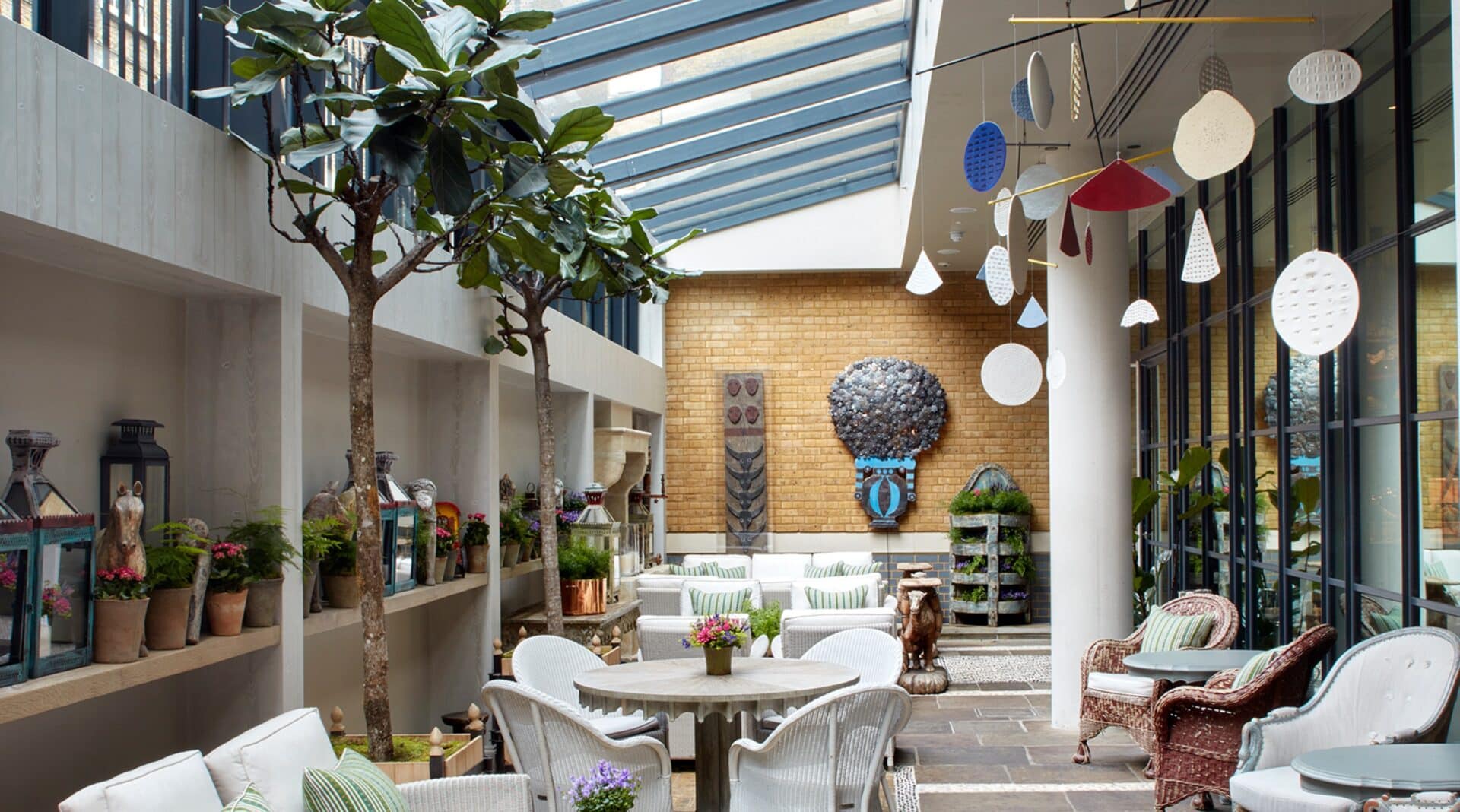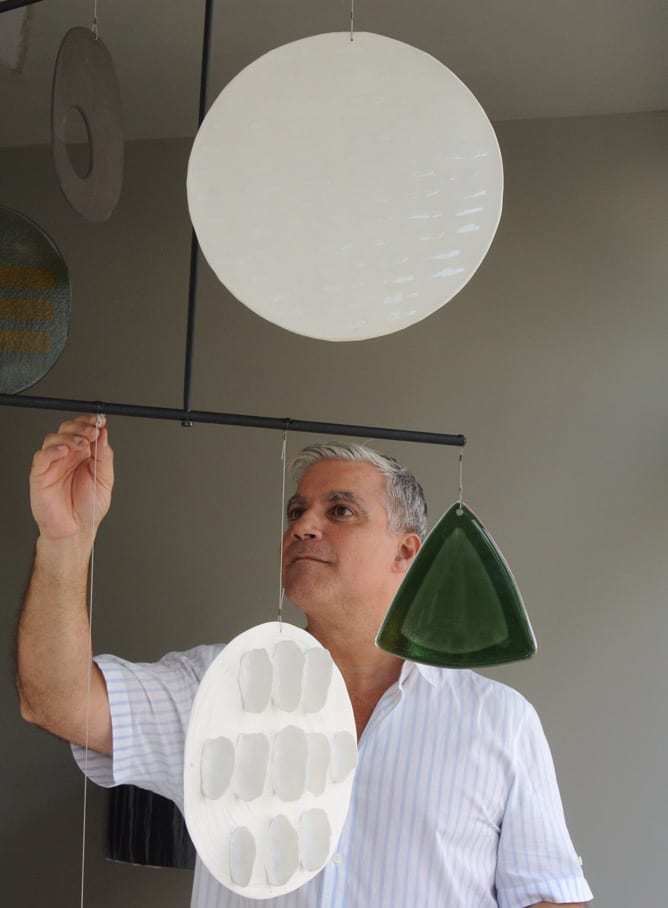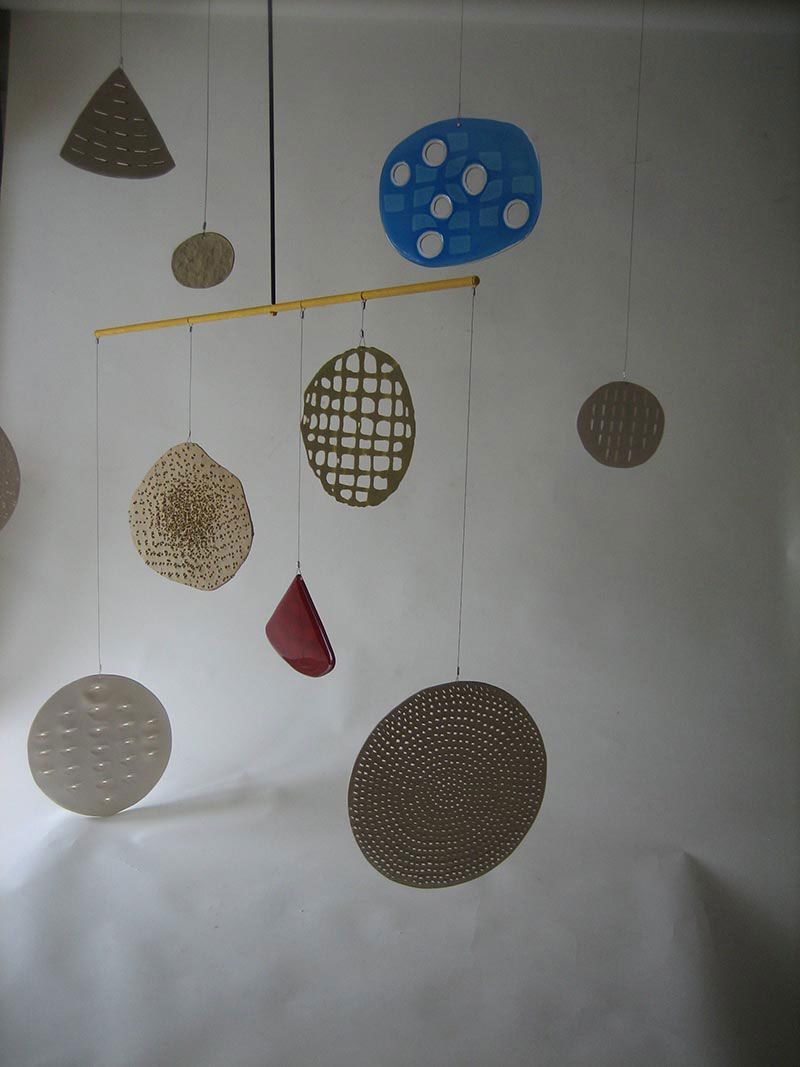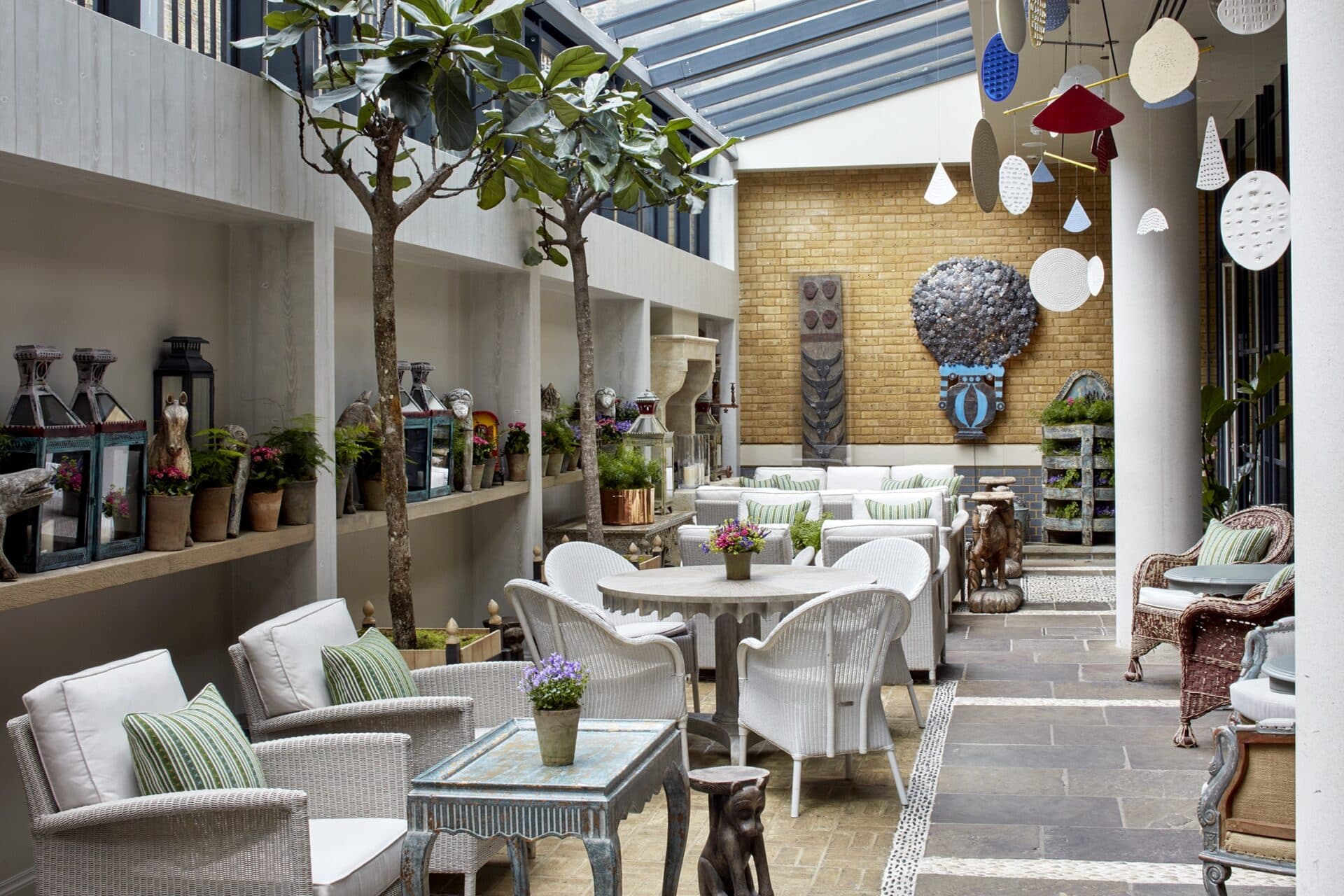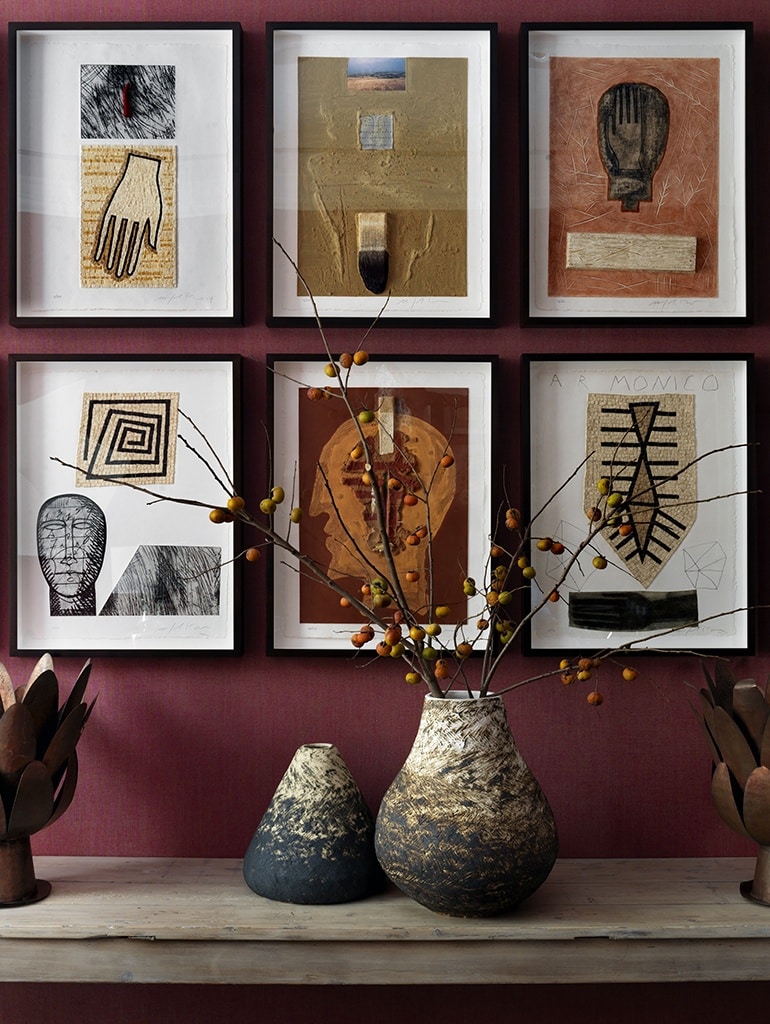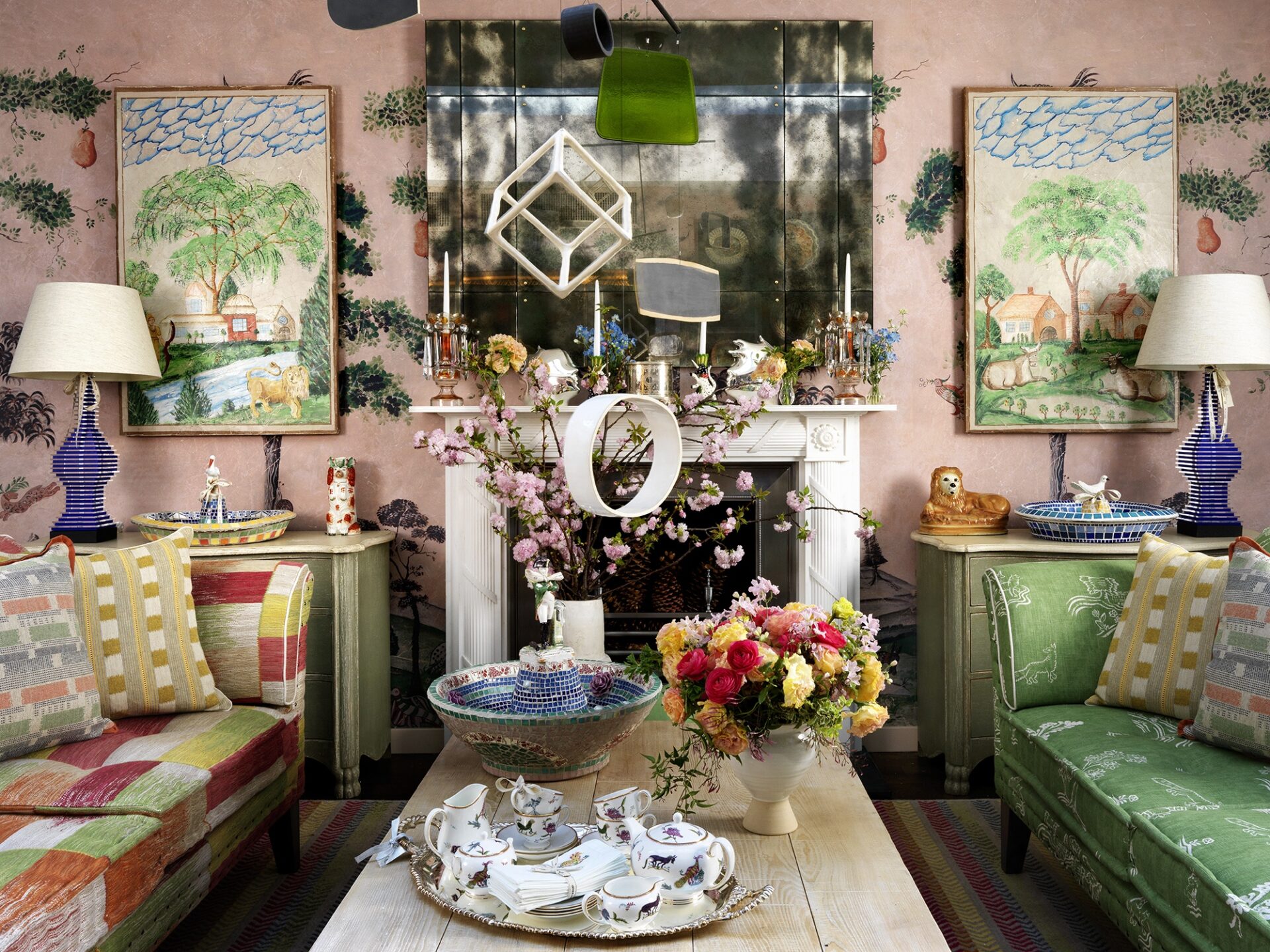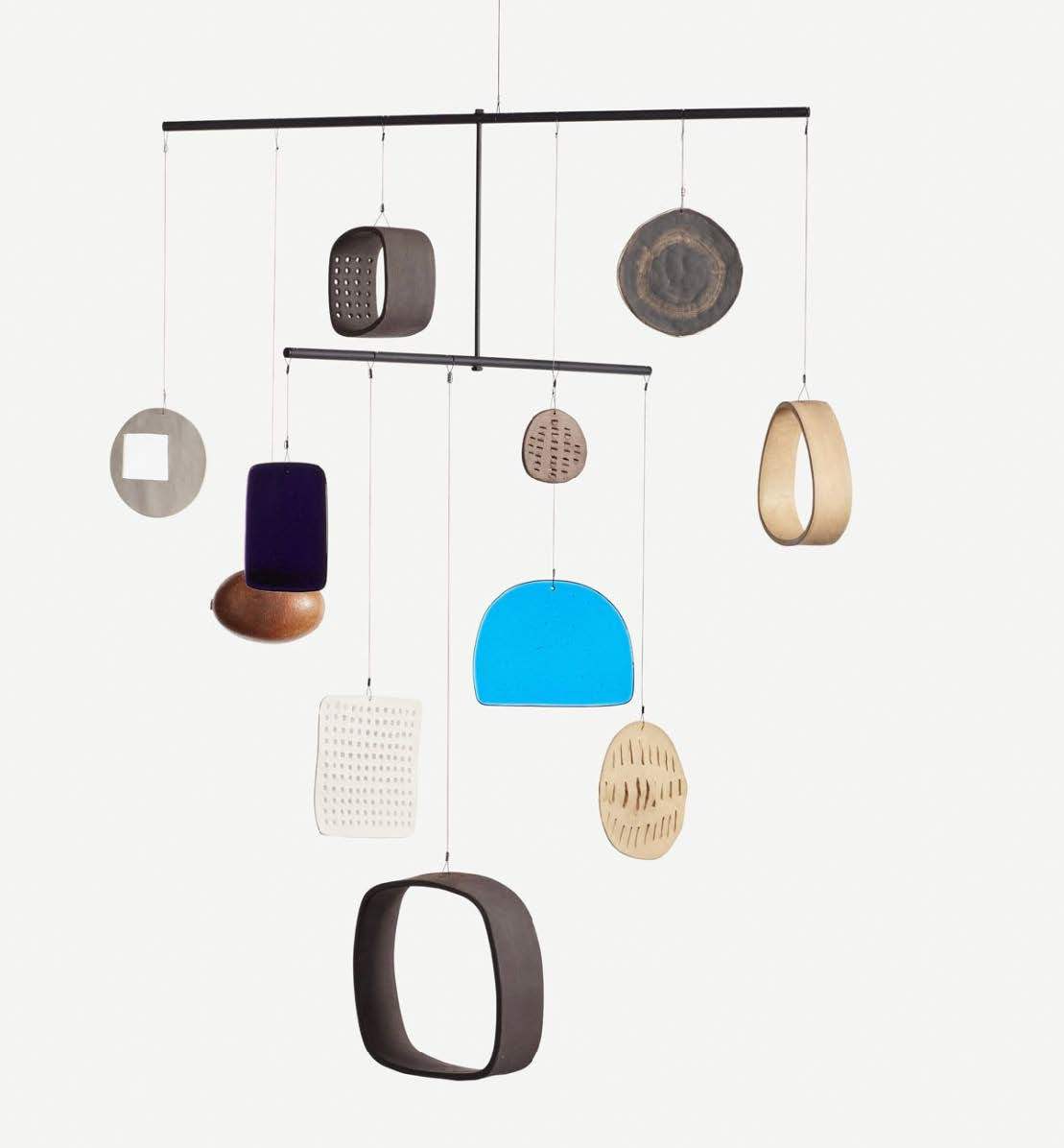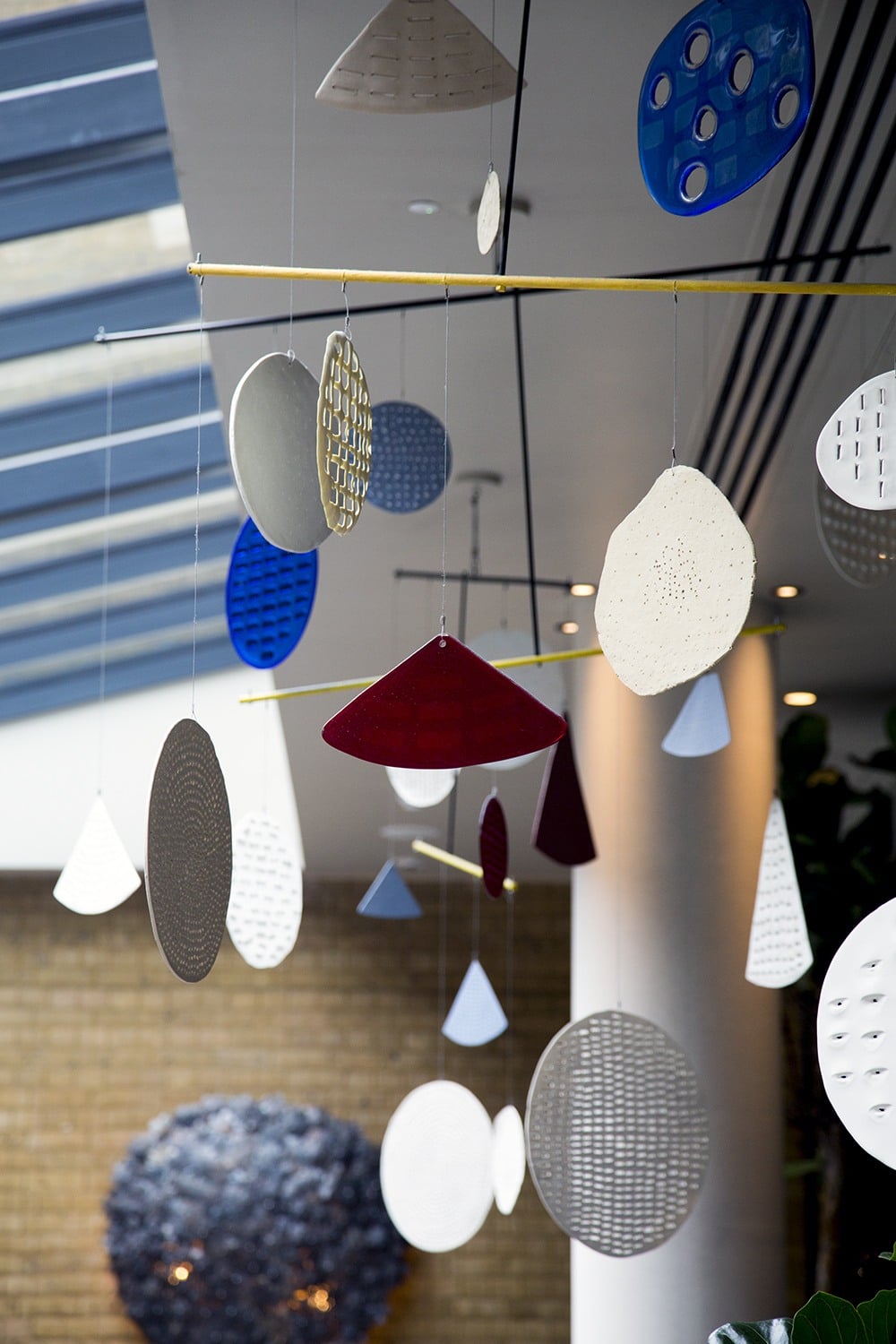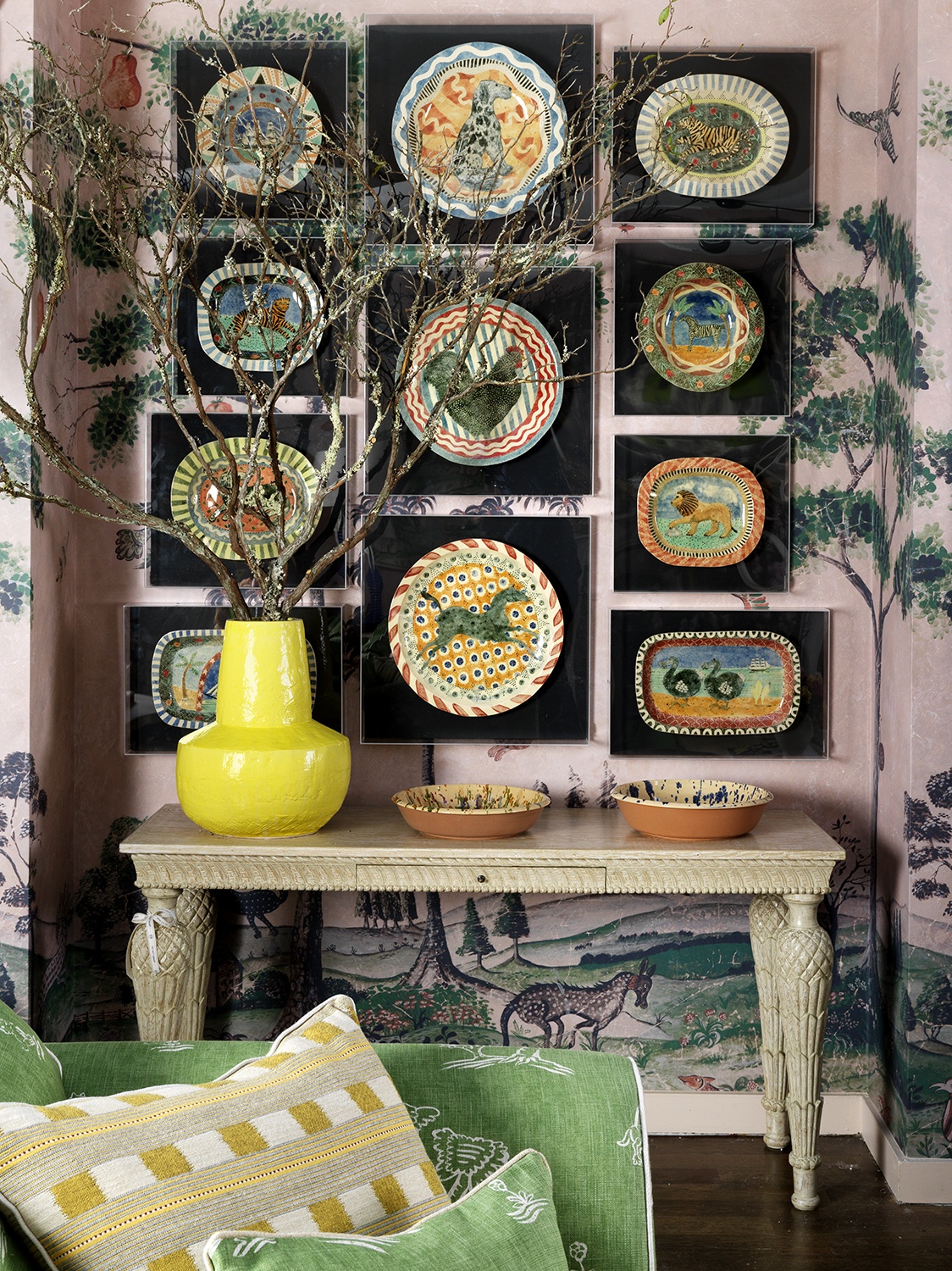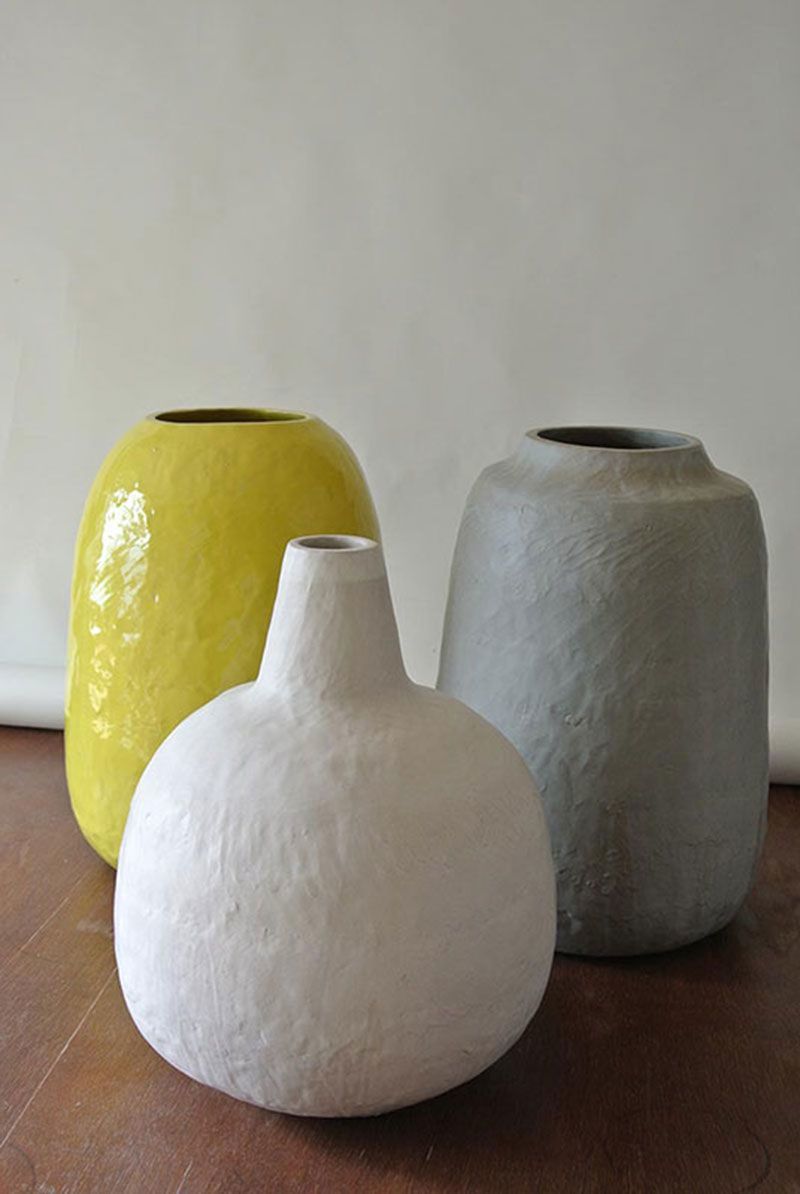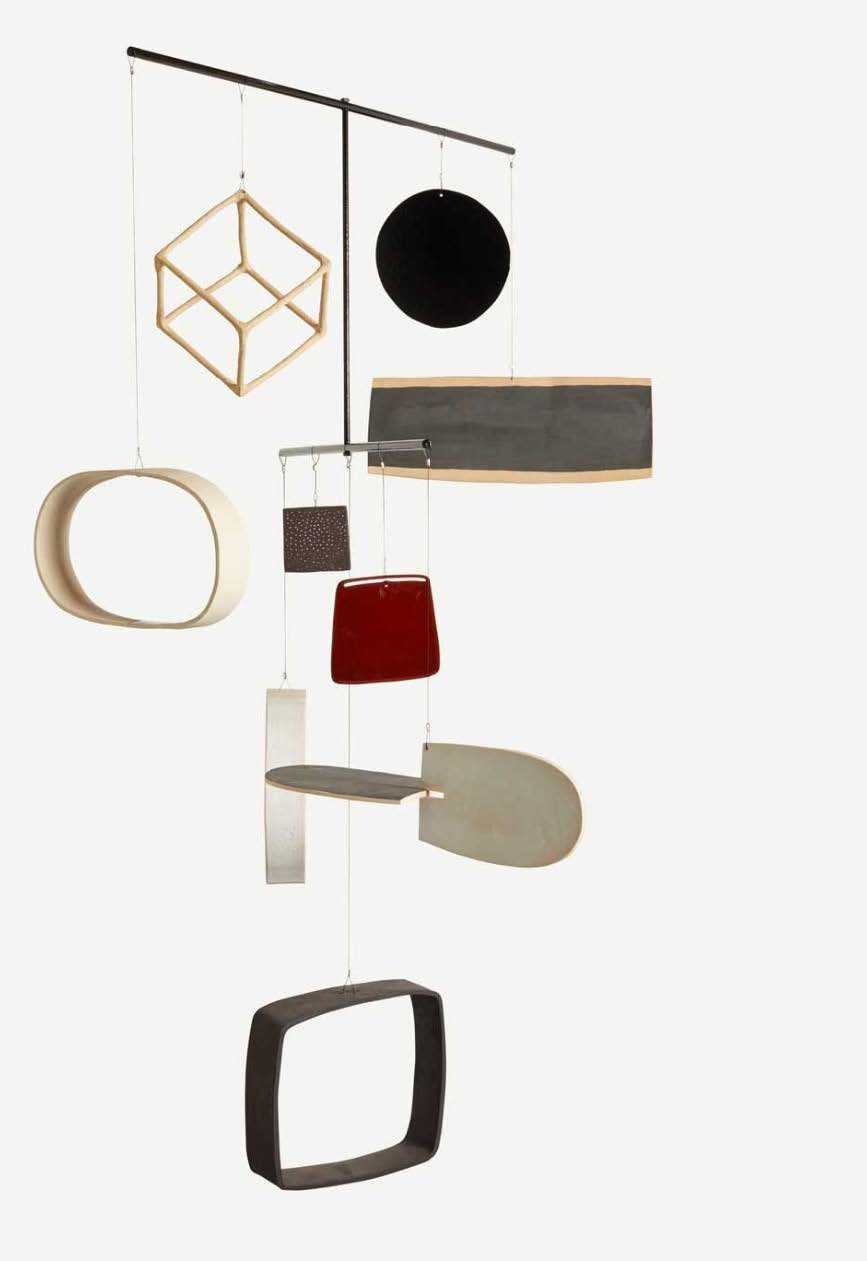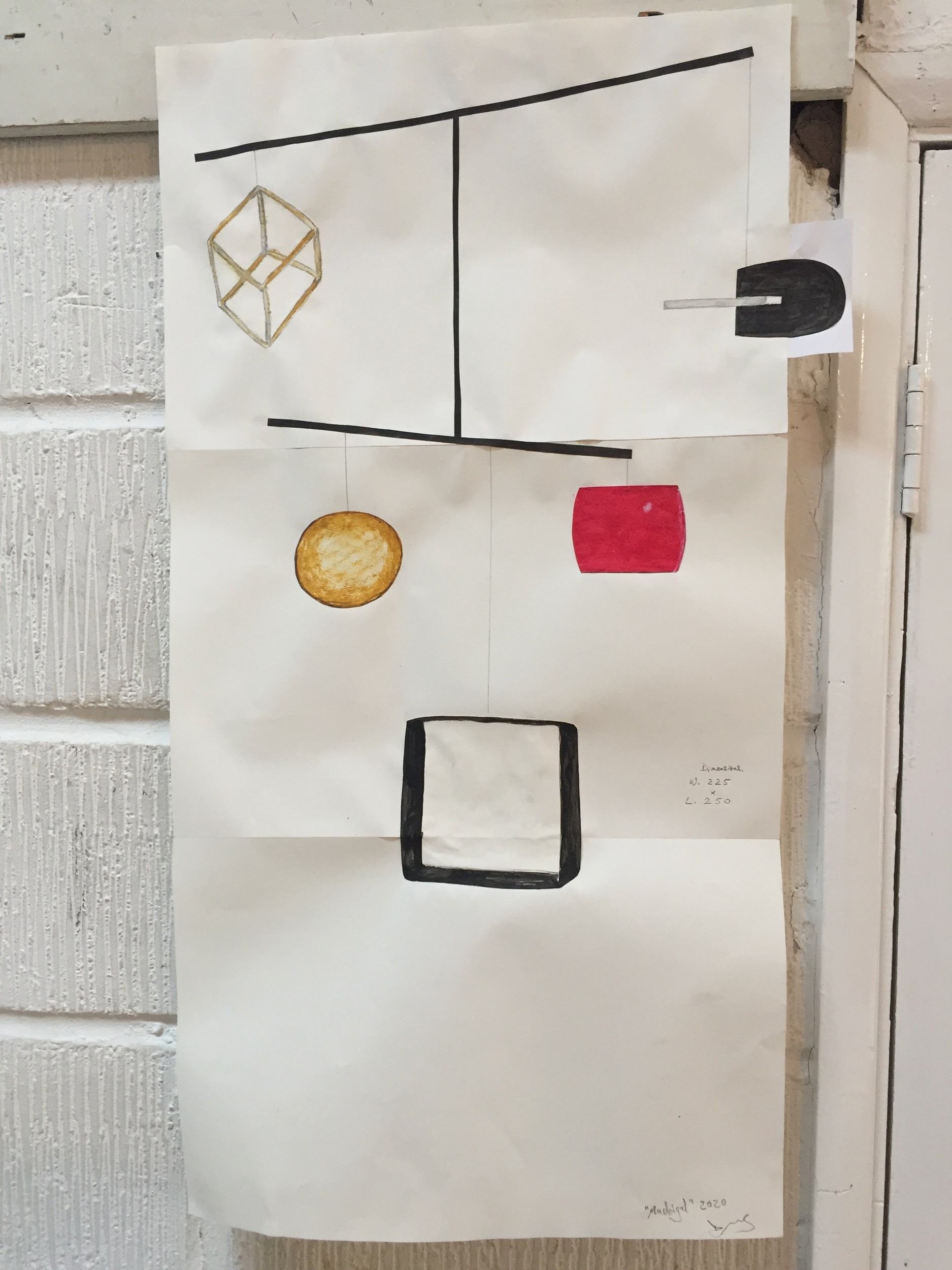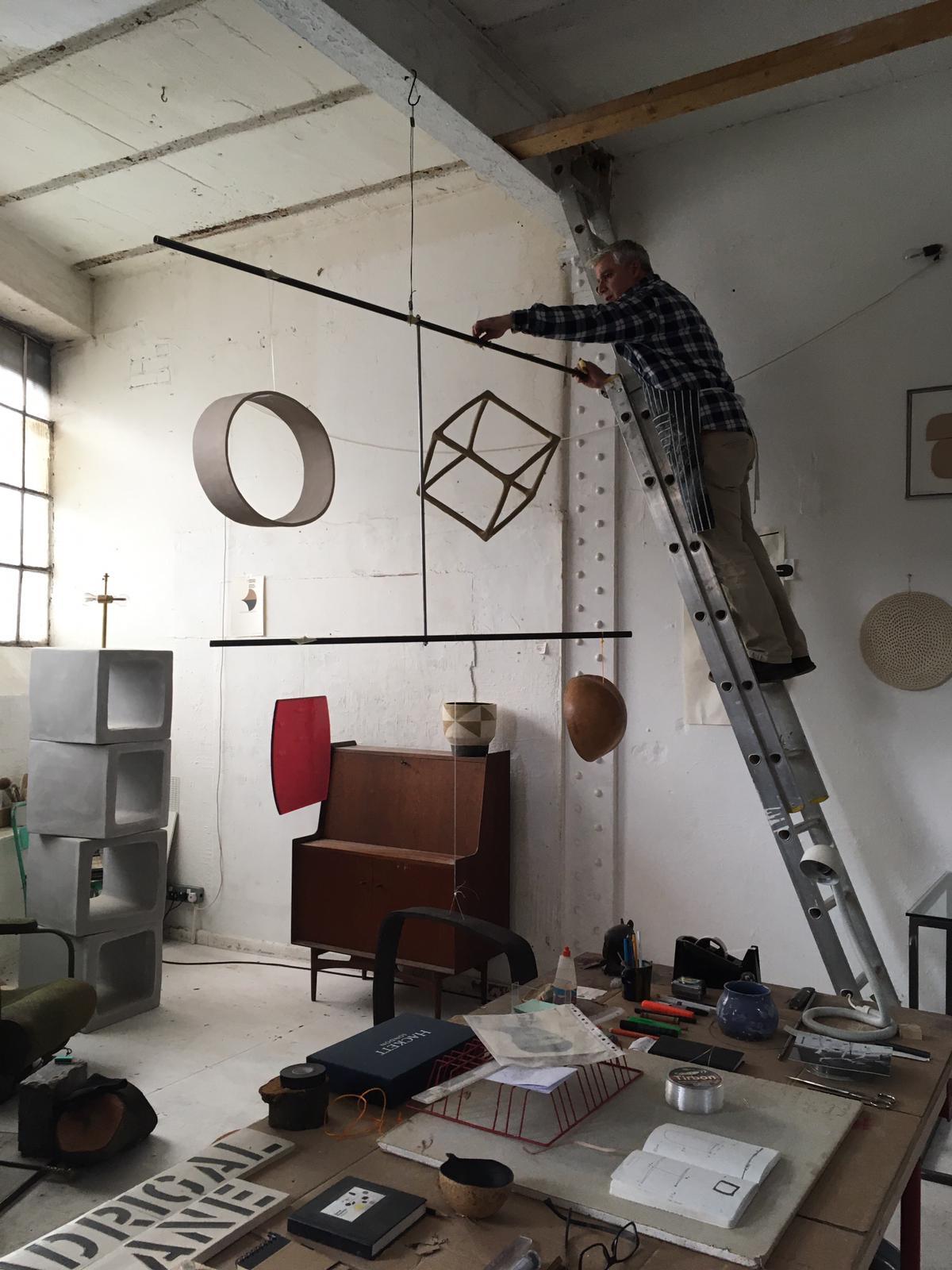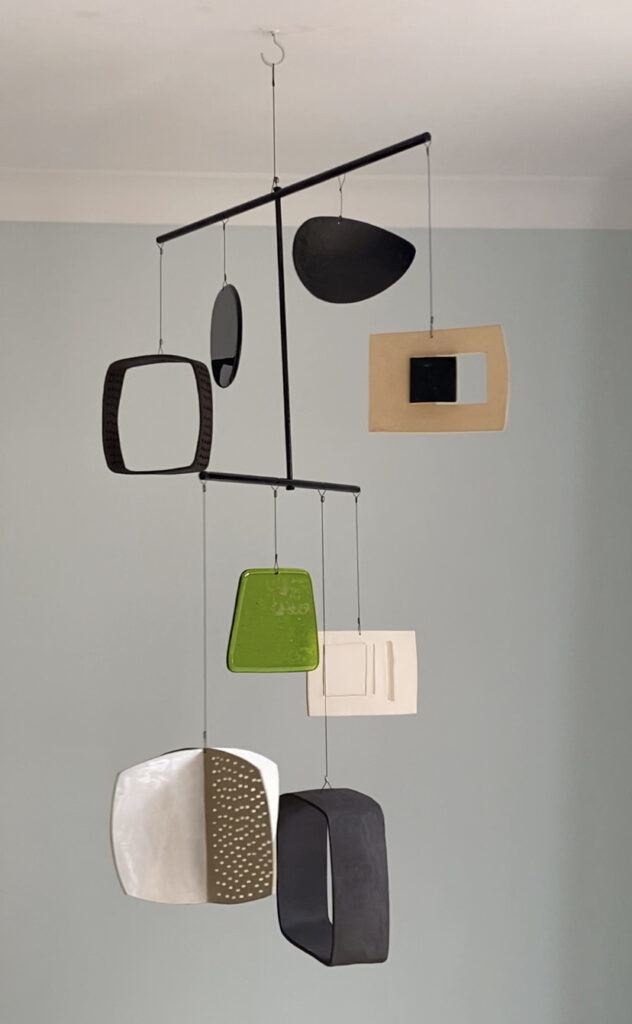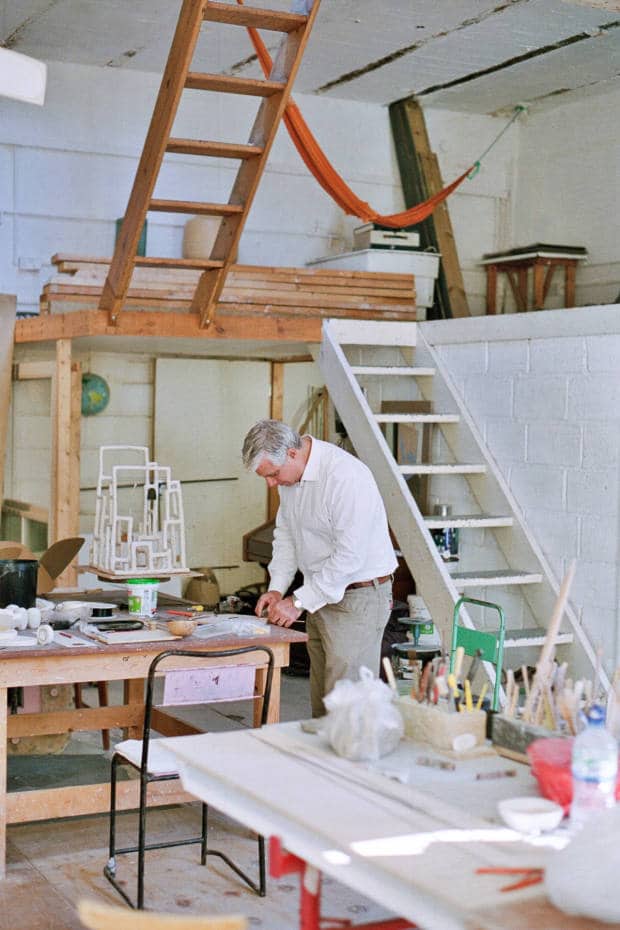My favourite artists are those who respond directly to the idea of space, their pieces are made to live and exist within an environment. One such artist is Daniel Reynolds, a sculptor and ceramicist, whose abstract mobiles and large ceramic vessels captured us a number of years ago. Born and raised in Venezuela, Reynolds spent his early years immersed in Venezuelan Modernism, surrounded by art and architecture which has clearly informed his work today.
Our favourite of Reynolds’ vast body of sculptural work are his mobiles. These kinetic sculptures interact subtly with the space in which they inhabit, capturing light and the gentle motion of the air around them, softly rotating and nodding to the best of late twentieth century modernism.
Whilst Reynolds’ work is subtle, championing clean lines and geometry, the hand-crafted quality of his pieces never fails to excite me. At Crosby Street Hotel, his pots sit pride of place in our drawing room, their rough and organic patina fits perfectly within the raw yet curated scene.
My first ever meeting with Reynolds was when I was purchasing some of his stoneware pots which I love for their scale and the prominence they hold in a room.
Reynolds had been playing around with some shapes which we found exciting and intriguing. We had the idea to develop them into a hanging sculpture, and the first step into Reynold’s now highly developed exploration into mobile sculptures began. We hung these first iterations in Ham Yard Hotel’s Orangery. They are true masterpieces with their Calder-esque feel, yet entirely the aesthetic of Reynolds. The mobiles combine jewel-like pieces of glass, perforated circles and perfectly formed stoneware bands.
As an avid patron of Reynolds’ work, our journey together continued. In 2019 we commissioned Reynolds to create a mobile for our pop up at Bergdorf Goodman in New York. He developed an entirely bespoke mobile and three of his gorgeous pots.
Recently, we had the pleasure of catching up with Reynolds to delve further into his practice and reminisce on the many projects we have worked on together.
These now hang together in The Orangery at Ham Yard Hotel in London, where guests can enjoy tea or cocktails whilst also being soothed and entertained by the light-play and gentle rotation of these pieces!
Since the creation of those three seminal sculptures, I have continued to add to the repertoire of shapes I use in putting together new work.
My sculptures now hang in private collections around the world: from New York to the Bahamas, Melbourne, Nice, of course London, Miami, Caracas and the Maldives.
One of the highlights for me recently, was the opportunity in 2018 to show a mobile especially commissioned for the inauguration of the Design House at The New Art Centre, Roche Court in Wiltshire.
It is so wonderful to see your work evolve and reach the heights that it deserves, tell us a little about how you have developed your mobile sculptures and some of your favourite pieces you have created.
My mobile sculptures developed from a desire to add gentle movement and interest to a space. For this I use a combination of geometric shapes made in porcelain stoneware and glass, with the occasional gourd or wooden element included.
Originally I had hung these individually from the ceiling of my studio in South London and watched them rotate for hours! Seeing how the changing light affected them and the way it played on the perforated sections gave a sort of calm joy to the space.
It was through our mutual friend, the talented designer Marcus Wells, that Kit conveyed to me her suggestion that I should explore putting a group of these elements together to create a single sculpture.
I of course loved the idea of this challenge and began working with three prime considerations at the core of the project: I wanted balance, colour and movement to be expressed through soft edged geometry, where the maker’s hand would be very much in evidence.
The result was a group of three large mobile sculptures using primary colours and mostly circles, ovals and triangles in fine porcelain and hand-fused glass, suspended from painted steel frames.
This is an extraordinary gallery and sculpture park owned by Lady Madeleine Bessborough, under the Creative Direction of Lewis Gilbert. They regularly show work by giants of modern British art such as Henry Moore, Barbara Hepworth, Ben Nicholson and Victor Pasmore, as well as championing contemporary art and craft to include names like Edmund de Waal, Peter Randall-Page, Eva Rothschild and Gavin Turk. I was delighted to have been asked by the then Creative Director, Stephen Feeke, to be part of that endeavour.
It was such a joy to work with you on our Bergdorf pop-up in NewYork two years ago. It was a true celebration of all our favourite artists and makers – we hope you had as much fun as we did!
Another great highlight came a year later during Kit’s collaboration with Bergdorf Goodman in 2019. It was a privilege to create work for that happy event, where I made a mobile sculpture and three large pots in Sun Yellow, Chalk White and Pistachio Green. The seventh floor of this extraordinary store was transformed into a sumptuous treasure trove of Kit’s beautiful vision for interiors. It was very special to be a part of it. The excitement and chic party atmosphere of the launch night was a marvellous experience!
Your pots have always captured us here at the Kit Kemp Design Studio, why is scale so important to you?
I made a conscious decision some years ago, to begin making a series of large voluminous pots in stoneware. I wanted these to be the kind of pieces that relate to the human body in scale and would almost want to make you hug them! In fact some of the early pieces were called ‘Hugging Pot in Blue’, or whatever colour they were. I might reinstate this nomenclature, as I feel it really does sum up their best qualities.
It was clear that by keeping to one block colour when decorating them, their shape or silhouette, almost monumental in their pared down simplicity, would remain at the fore.
It is my aim that these pieces lend weight and at the same time a kind of joy and peace to a space.
How have your roots inspired your work today?
My father was a Chicagoan born and bred, and my mother is Venezuelan, from a beautiful small town on the coast. My roots have always played an important part in the shaping of my aesthetic and process.
I was born in the tropics in Caracas in the 1960s and lived there until the age of 9. The combination of exquisite modernist art and architecture, with the exuberance of tropical vegetation and landscape made an indelible impact which continues to inspire me when creating new work.
My parents were collectors of modern American and British art, which gave my siblings and me a visual language from early childhood. Caracas in the 1960s was a treasure trove of public sculpture and architecture by great artists such as Alexander Calder, Victor Vasarely, Fernand Léger, Jean Arp, Jesús Soto, Oscar Niemeyer, Roberto Burle Marx and Gio Ponti.
Frequent visits to Chicago also introduced me to the marvels of the architecture of this fabulous metropolis. For a kid with his eyes open, all this will inevitably have had an impact!
My education continued in England when we moved here as a family. I was at boarding school in Oxfordshire where the Art Department was run by the talented British sculptor Michael O’Connor. As a collector of British and Japanese contemporary ceramics, with works by Bernard Leach, Gordon Baldwin and Shoji Hamada, he introduced me to the possibilities of this medium. He was an important influence during my adolescent years, allowing me free reign to create sculpture and painting at will, and placing little emphasis on the required rigours of art exams. O and A Level Art were viewed as something to get through without allowing them to stifle innate creativity; an enlightened view at the time, for which I remain grateful!
Tell us a little about the relationship between form and function within your work?
My work is predominately in the field of abstract sculpture and in this respect I feel their function is primarily to enhance and enrich the space they occupy; be they mobiles, static sculptures or framed reliefs to be hung on the wall. That said, I’m sure I will always want to continue to build large pots by hand. I love the process and the results!
Where vessels are concerned, I try to follow the traditions of hand building from around the world, which have come down to us over the centuries, whilst adding a modern dimension to the work.
What is your process when making one of your pieces?
With regard to the mobile sculptures, a lot of my process involves looking for long periods of time at the objects I propose to combine. I tend to make groups of elements which I build up as a collection from which to choose. Both the physical and visual balance are equally important in determining which elements to combine and how to place them on the steel rod frame.
My aim is to create a piece which will exude harmony, balance, and a kind of quiet joy from the rotation and play of light over the individual pieces. This approach makes each sculpture unique.
Where would be your dream place to hang one of your sculptures?
The idea of my sculptures made to a monumental scale and placed in public spaces is very appealing to me. I would enjoy seeing people interact with them within the context of a city and in relation to architecture.
The largest piece I have made to date, ‘Madrigal’, a mobile measuring 2.5 x 2.7 metres which I showed at Collect 2020 in London, would work well in an atrium, a staircase or similar large space.
It would be a dream come true, Kit having been instrumental in originating the very first of these pieces, to see this work hanging in one of the new Firmdale hotels!
I would also love to see these sculptures finding their way eventually into the great museums of modern art around the world ..I believe in aiming high!
We think your work has such a sensitive relationship to space. From your sculptures, to your kinetic mobiles and large sumptuous pots, all your work packs a punch yet sinks into its environment so beautifully – how do you strike this balance when creating a piece?
My approach tends to be to look at a space and ask what one of my works can bring to it. I aim to lend a room a sense of joy and interest, with the use of sculptures that dance delicately within a space or with simple voluminous vessels to bring colour and calm contemplation to the viewer.
How have your past creative endeavours informed your work today?
I feel that one piece or project informs and has a bearing on the next. I see my creative progress very much as a progression.
Abstract sculpture has been a passion from my earliest days. This however did not stop me from formally studying furniture design, when as a young art student I feared I might struggle to make a living from my sculptures alone.
Later, remembering the joy of working with clay from my school days, I decided to set up a ceramics studio and to see whether the client base I had developed during my brief furniture practice, could be persuaded to follow me down this new path.
I am happy to report that luck smiled on me in this regard and I was afforded the opportunity to pursue the avenues of creativity, pretty much as they presented themselves within the pages of my sketch book!
Tell us a little bit about your day to day – are you an early bird or a night owl? We’re dying to know more about what a day in the life of Daniel Reynolds looks like?
I like to get up early and start my day with a walk, a cycle ride or rowing along the Kent coast, where we spend most of our time. I travel to London (when lockdown allows), about three times a week to my studio in Camberwell. Here there are four of us, by some happy coincidence all sculptors, working in our individual studios within a large converted former butter factory built in the 1930s: Bill Woodrow, Sandra Treagus, Anish Kapoor and me. The rest of the week I work from an impromptu studio in our garden at home.
The day at the studio consists of tending to several projects that are often in progress at any one time. As you can imagine, if building a large ceramic pot by hand, rather than throwing on the wheel, this needs to be done in stages; allowing the base to be firm enough to support the weight of the new clay on top. For this reason, these pieces tend to be made in groups of three to five. A cohesiveness to the dialogue between their differing shapes also results from this approach.
Then I may look at choosing elements for a new mobile sculpture from pieces displayed on a large table; almost like a tasting menu from which to select the right combination of shapes, colours and weights to achieve the required balance in a work.
I have recently been developing a series of reliefs in stoneware and in wood based on some of my work in sculpture, particularly at the moment the ‘propellor’ shapes I have been using in my kinetic work. These new pieces for the wall require a different approach, involving as well as ceramic, painted wood, together with aluminium frames made for me at a small workshop in Broadstairs, Kent.
I hope also soon to devote time to working on a series of large canvases which have been waiting patiently in my studio for far too long!
We have worked with Reynolds for many years and are overjoyed to have been part of his journey as an artist, we can’t wait to see what he creates next.

